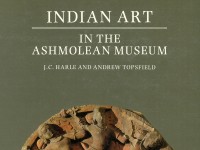Indian Art in the Ashmolean Museum
A catalogue of the Ashmolean’s collection of Indian art by J. C. Harle and Andrew Topsfield (published Oxford, 1987).

Publications online: 143 objects
- Reference URL
Actions
A lady awaiting her lover in a grove, illustrating the musical mode Kamodani Ragini
-
Literature notes
During the 17th and 18th centuries the local styles of painting at the semi-independent Rajput courts of Rajasthan, Central India and the Punjab Hills were strongly influenced by the imperial Mughal School. But in spite of the new popularity of portraiture, hunting scenes and other Mughal genres, the earlier tradition of poetical and devotional manuscript illustration also continued to flourish. The most common theme was rāgamālā, the representation of musical modes (rāgas) were endowed with families of “wives” (rāgiṇīs) and, in some systems, “sons” (putras) as well. Most rāgamālās comprise 36 rāgas and rāginīs, but longer series are not uncommon. The conventional pictorial subjects are usually of ladies and princes seen in palaces or flowering groves, with a prevailing mood of erotic longing or fulfilment.
In this page Kamodanī rāginī is depicted, according to a tradition followed at the neighbouring courts of Bundhi and Kotah in south-east Rajasthan, as a lady preparing for a lover’s tryst in a grove. According to the Sanskrit verses inscribed on the wide red border, she stretches out her lotus-like hand to collect the flowers, applied musk to her forehead, sits on a seat of flowers and has “a soft and fair body”. A young girl, like the apsaras Ra[ṁ]bha, dwelling in the heavenly realm, she is to be sung during the third watch of the day in the cold season, from the note Madhyama”. It belongs to a rāgamālā of 36 pages which has been identified by Ebeling as a short version deriving from a huge series of 240 rāga pictures painted at Kotah in 1768, most of which are in the Sarasvatī Bhavan Library, Udaipur. Other pages from the present series are in the National Museum, New Delhi. -
Details
- Series
- Garland of Ragas
- Associated place
-
Asia › India › west India › Rajasthan › south Rajasthan › Bundi (probable place of creation)Asia › India › west India › Rajasthan › south Rajasthan › Kota (possible place of creation)
- Date
- c. 1770
- Material and technique
- gouache with gold and silver on paper
- Dimensions
-
mount 55.5 x 40.4 cm (height x width)
painting with border 36.3 x 25.6 cm (height x width)
painting 21 x 12.5 cm (height x width)
- Material index
- Technique index
- Object type index
- No. of items
- 1
- Credit line
- Presented by Lord Somervell, 1958.
- Accession no.
- EA1958.148
-
Further reading
Harle, J. C., and Andrew Topsfield, Indian Art in the Ashmolean Museum (Oxford: Ashmolean Museum, 1987), no. 88 on pp. 79-80, pp. 79 & 93, pl. 16 (colour) & p. 80
Rawson, Philip, Indian Painting (Paris: P. Tisné and New York: Universe Books, 1961), illus. 139
Glossary
Ragini
-
Ragini
Raga (feminine ragini) are musical modes, often represented by compositions of ladies, lovers, warriors, animals or gods, in series of Ragamala ('Garland of Ragas') paintings, a very popular artistic genre in north India and the Deccan c. 1500 - 1800.
Location
-
- currently in research collection
Objects are sometimes moved to a different location. Our object location data is usually updated on a monthly basis. Contact the Jameel Study Centre if you are planning to visit the museum to see a particular object on display, or would like to arrange an appointment to see an object in our reserve collections.
Publications online
-

Indian Art in the Ashmolean Museum
During the 17th and 18th centuries the local styles of painting at the semi-independent Rajput courts of Rajasthan, Central India and the Punjab Hills were strongly influenced by the imperial Mughal School. But in spite of the new popularity of portraiture, hunting scenes and other Mughal genres, the earlier tradition of poetical and devotional manuscript illustration also continued to flourish. The most common theme was rāgamālā, the representation of musical modes (rāgas) were endowed with families of “wives” (rāgiṇīs) and, in some systems, “sons” (putras) as well. Most rāgamālās comprise 36 rāgas and rāginīs, but longer series are not uncommon. The conventional pictorial subjects are usually of ladies and princes seen in palaces or flowering groves, with a prevailing mood of erotic longing or fulfilment.
In this page Kamodanī rāginī is depicted, according to a tradition followed at the neighbouring courts of Bundhi and Kotah in south-east Rajasthan, as a lady preparing for a lover’s tryst in a grove. According to the Sanskrit verses inscribed on the wide red border, she stretches out her lotus-like hand to collect the flowers, applied musk to her forehead, sits on a seat of flowers and has “a soft and fair body”. A young girl, like the apsaras Ra[ṁ]bha, dwelling in the heavenly realm, she is to be sung during the third watch of the day in the cold season, from the note Madhyama”. It belongs to a rāgamālā of 36 pages which has been identified by Ebeling as a short version deriving from a huge series of 240 rāga pictures painted at Kotah in 1768, most of which are in the Sarasvatī Bhavan Library, Udaipur. Other pages from the present series are in the National Museum, New Delhi.
Notice
Object information may not accurately reflect the actual contents of the original publication, since our online objects contain current information held in our collections database. Click on 'buy this publication' to purchase printed versions of our online publications, where available, or contact the Jameel Study Centre to arrange access to books on our collections that are now out of print.
© 2013 University of Oxford - Ashmolean Museum

